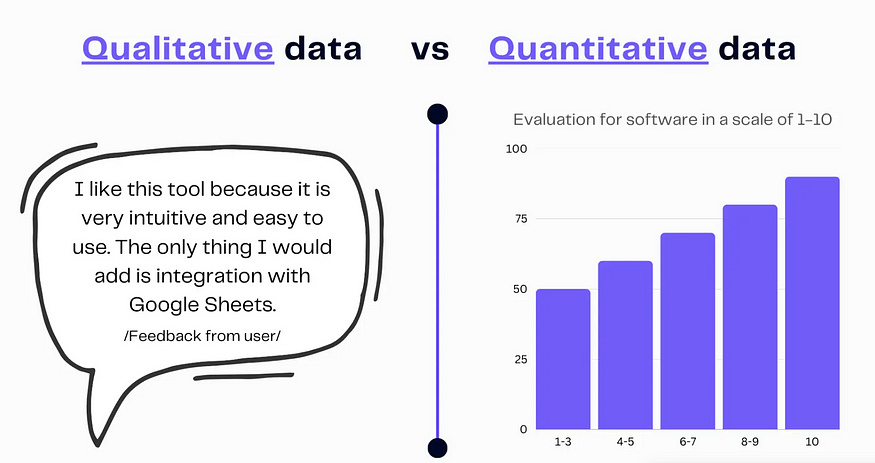Understanding the types of data is crucial as it determines the appropriate statistical methods to apply. Broadly, data can be categorized into the following types:

Precisely,
Quantitive || Numerical — Measurable Quantities
Let’s start with numeric data types — numbers, everyone’s favorite topic!! Numeric data types are expressed on a numerical scale.
It answers key questions such as “how many, “how much” and “how often”.
Examples can be:-
- Scores on tests and exams e.g. 85, 67, 90, etc.
- The weight of a person or a subject.
- Your shoe size.
- The temperature in a room.
What might not be so obvious is that there are two subcategories, which are continuous and discrete.

Continuous Data:
Data that can take any value within a range (e.g., height, weight, temperature).It often involves measurements and can have fractional or decimal values.
Examples:
- Number of Cars in a Parking Lot: 0, 1, 2, 3, …
- Number of People in a Household: 1, 2, 3, …

Discrete Data:
Discrete data consists of distinct, separate values or whole numbers. These values often represent counts or can be counted.
Examples:
- Height of Individuals: Can be any value between a minimum and maximum height.
- Temperature in Celsius or Fahrenheit: Can be 25.5°C, 26.3°C, etc.

Choosing the Right Chart type is always essential.

Qualitative || Categorical — Descriptive attributes
Categorical data deals with descriptive attributes, often involving words, providing richer context and insights. The difference lies like the data; one is numeric, while the other is descriptive.
Qualitative data is particularly effective when it comes to understanding people’s feelings and attitudes.
It can also provide valuable insight into their preferences and needs, which can be invaluable in the process of making decisions and improving services.
Nominal Data:
Nominal data represents categories or labels with no inherent order or ranking or without a natural order.
Examples:
- Colors: Red, blue, green, etc.
- Gender: Male, female, non-binary, etc.
- Types of Animals: Dogs, cats, birds, etc.

To Conclude,

Ordinal:
Categories with a natural order (e.g., rankings, satisfaction levels). It adds a level of ranking or order among them. The order matters.
Examples:
- Educational Qualifications: High school diploma, bachelor’s degree, master’s degree, Ph.D.
- Customer Satisfaction Ratings: Poor, fair, good, excellent.

To Conclude,

Interval Data
Interval values represent ordered units that have the same difference. Therefore we speak of interval data when we have a variable that contains numeric values that are ordered and where we know the exact differences between the values.

An example would be a feature that contains the temperature of a given place you can see below:

The problem with interval values data is that they don’t have a true zero. That means in regards to our example, that there is no such thing as no temperature.
Lets understand this one more time,
For example, consider these temperatures: 15°C in the USA and 30°C in India. We can say that the temperature difference between the USA and India is 15°C. However, it is incorrect to say India is twice as hot as the USA.
To understand this better, note that 0°C does not mean that temperature does not exist at 0°C, i.e., the temperature is measured as 0 only in units, and this does not mean that temperature is absent at this point. In interval data, the zero point is arbitrary and does not signify the total absence of what is being measured.
Therefore, using ratios to compare values, such as saying that 20°C is twice as hot as 10 °C, is not meaningful in the context of interval data.
The scale provides information about the order and intervals between values, but ratios lack significance in representing proportional differences without a true zero point.
To Conclude,

Ratio Data
When data has the properties of Interval data and ratios are meaningful, it is known as ratio data or Interval data with Zero Included ratio data.

Considering the weight of two friends, A and B, A is 50 kg, and B is 100 kg, we can undoubtedly say that B is twice as heavy as A.
To Conclude,


An Easy Peasy way to remember: 😁
Nominal information is represented by labels or descriptions.
Nominal information with a meaningful order assigned is Ordinal information.
Ordinal information with meaningful interval differences is Interval information.
Interval information with meaningful ratios is Ratio information.
Nutshell,

How is qualitative data analysis different from quantitative data analysis?

Qualitative and quantitative data analysis are distinct methods used in research to process different types of data.
Qualitative analysis focuses on understanding the depth and complexity of non-numerical data to uncover patterns, themes, and meanings. It’s interpretive, aiming to grasp the ‘how’ and ‘why’ behind human behavior, experiences, or attitudes.
On the other hand, quantitative analysis deals with numerical data, employing statistical techniques to quantify and analyze variables. It seeks to identify statistical relationships, trends, or differences, aiming for results that can be generalized across populations.
While qualitative analysis provides in-depth insights and a deeper understanding of the subject matter, quantitative analysis offers measurable and often generalizable findings, highlighting the ‘how many’ or ‘how much’ aspects.
Qualitative and quantitative data analysis differ in several key aspects:
- Data Form: Qualitative analysis works with textual or visual data, while quantitative analysis deals with numerical data.
- Analysis Process: Qualitative methods involve thematic or content analysis to identify patterns, whereas quantitative methods use statistical tools for analysis.
- Objective: Qualitative analysis aims to explore concepts and understand phenomena depth, while quantitative analysis seeks to test hypotheses and measure variables.
- Outcome: Qualitative research results in rich, detailed descriptions, whereas quantitative research produces numerical and statistically significant outcomes.

About the Author

Connect with me on LinkedIn
If you love reading this blog, share it with friends! ✌️
Tell the world what makes this blog special for you by leaving a review or like here 🙂 😁




Thanks I have just been looking for information about this subject for a long time and yours is the best Ive discovered till now However what in regards to the bottom line Are you certain in regards to the supply